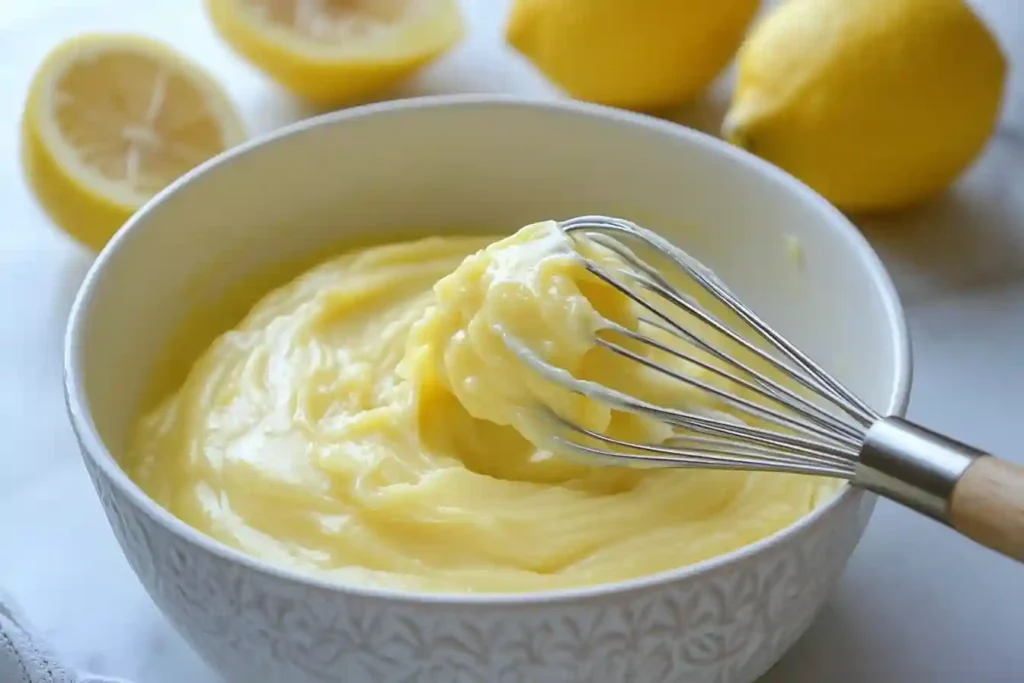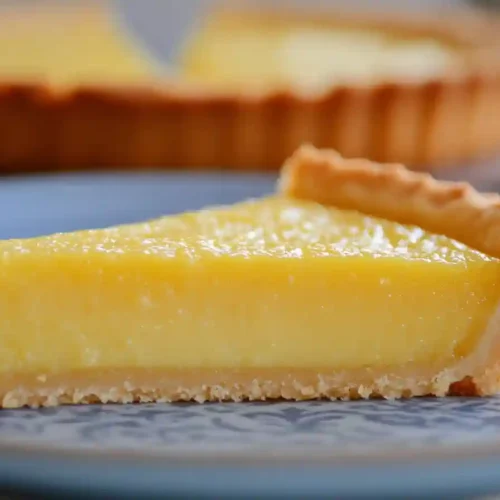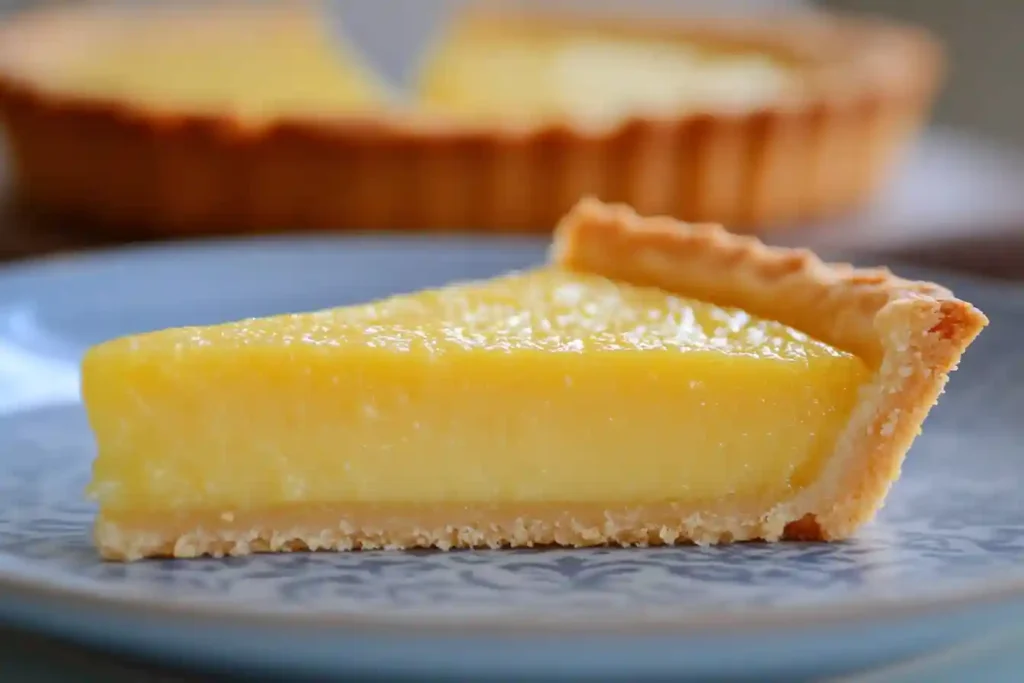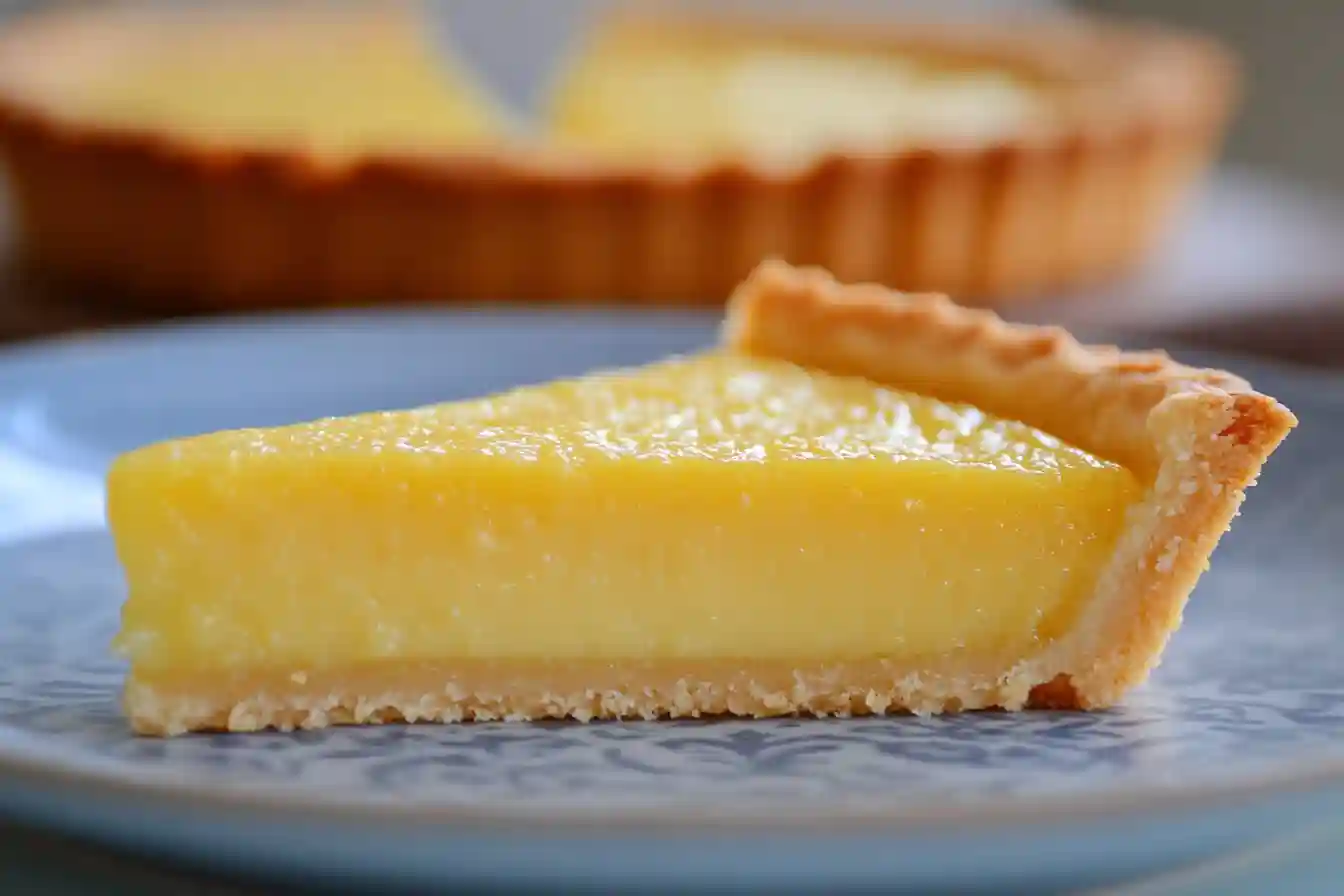A Vegan Lemon Curd Tart is a delightful plant-based twist on the classic lemon tart, offering the same tangy sweetness and creamy texture without using any animal products. This dessert is a perfect blend of a buttery crust and a zesty lemon filling that melts in your mouth. Whether you’re vegan or simply looking for a dairy-free dessert, this recipe is sure to impress.
Why should you choose a Vegan Lemon Curd Tart over a traditional one? For starters, it’s a healthier option that doesn’t compromise on flavor. Vegan recipes often use natural ingredients that are free from cholesterol and lower in saturated fats. Plus, it’s an environmentally friendly choice, aligning with the growing movement toward sustainable eating.
Interestingly, the origins of lemon tarts date back to medieval Europe, where citrus fruits were considered a luxury. Over time, the dessert evolved into a symbol of refinement, and today, vegan adaptations make it accessible to a broader audience while retaining its elegance.
In this guide, we’ll cover everything you need to know to create the perfect Vegan Lemon Curd Tart from scratch, including ingredients, tools, preparation, and more.
Table of Contents
Ingredients for Vegan Lemon Curd Tart
Creating a Vegan Lemon Curd Tart starts with selecting the right ingredients. Each component plays a crucial role in achieving the desired texture and flavor. Below is a breakdown of the essential ingredients:
Key Components for the Perfect Vegan Lemon Curd
- Lemons: Fresh lemons are the star of the show. Their zest and juice provide the tangy flavor that defines this dessert.
- Plant-Based Milk: Almond, soy, or oat milk works well as a base for the lemon curd, ensuring a creamy consistency.
- Sweetener: Organic cane sugar or maple syrup is used to balance the tartness of the lemons.
- Cornstarch or Arrowroot Powder: These thickeners replace eggs, creating a smooth and firm filling.
- Vegan Butter: Adds richness to the curd while enhancing the overall texture.
Substitute Options for Special Diets
- For a gluten-free crust, swap all-purpose flour with a mix of almond flour and gluten-free all-purpose flour.
- Use coconut sugar or agave syrup as a healthier alternative to refined sugar.
- Opt for soy-free vegan butter if you have allergies.
Pro Tips for Sourcing High-Quality Vegan Ingredients
- Choose organic lemons for the best flavor and to avoid any waxy residue.
- Look for plant-based milk with a neutral taste to avoid overpowering the lemon flavor.
- Ensure your sugar is labeled as vegan, as some brands process sugar with bone char.
Tools and Equipment You’ll Need
Having the right tools can make all the difference in creating a flawless Vegan Lemon Curd Tart. Here’s what you’ll need:
Must-Have Baking Tools for Tarts
- Tart Pan: A pan with a removable bottom ensures easy release and a professional presentation.
- Mixing Bowls: Several bowls of different sizes for mixing crust and filling ingredients.
- Whisk: Essential for achieving a lump-free lemon curd.
Optional Gadgets to Simplify the Process
- Citrus Zester: Makes zesting lemons quick and effortless.
- Food Processor: Ideal for blending crust ingredients for a perfectly even texture.
- Pastry Brush: Useful for applying glazes or brushing the crust.
Eco-Friendly Kitchen Tools for Sustainable Cooking
Consider using silicone baking mats instead of parchment paper and reusable silicone whisk or spatula sets to reduce waste.
Preparing the Vegan Tart Crust
The crust is the foundation of any tart, and a flaky, buttery vegan crust will set the stage for your lemon curd. Follow these steps to make a foolproof crust:
Step-by-Step Instructions for Making a Flaky Vegan Crust
- Combine Dry Ingredients: In a mixing bowl, whisk together flour, sugar, and a pinch of salt.
- Add Vegan Butter: Cut cold vegan butter into small cubes and incorporate it into the flour using a pastry cutter or your hands until the mixture resembles coarse crumbs.
- Mix Wet Ingredients: Gradually add ice-cold water, one tablespoon at a time, until the dough comes together.
- Chill the Dough: Wrap the dough in plastic wrap or an eco-friendly alternative and refrigerate for at least 30 minutes.

Common Mistakes to Avoid While Preparing the Crust
- Overworking the dough can lead to a tough crust. Handle it gently and only mix until combined.
- Skipping the chilling step can cause the crust to shrink or become uneven during baking.
Tips for Pre-Baking or Blind-Baking the Crust
- Roll out the dough on a floured surface and transfer it to your tart pan.
- Prick the bottom with a fork to prevent air bubbles.
- Use pie weights or dried beans during blind baking to maintain the crust’s shape.
Crafting the Perfect Vegan Lemon Curd
The lemon curd is the heart of this tart, and getting it right ensures a dessert that’s both visually appealing and delicious.
The Role of Plant-Based Alternatives in Vegan Lemon Curd
Without eggs or dairy, the lemon curd relies on plant-based milk and thickeners like cornstarch to achieve a silky texture. Vegan butter adds richness, while sugar balances the natural acidity of lemons.
Step-by-Step Process for Silky-Smooth Lemon Curd
- Zest and Juice Lemons: Combine lemon zest and juice in a saucepan for the boldest flavor.
- Mix Dry Ingredients: Whisk sugar and cornstarch in a separate bowl.
- Combine and Heat: Gradually add plant-based milk to the sugar mixture, whisking constantly to avoid lumps. Pour this into the saucepan with the lemon juice and zest.
- Cook Until Thickened: Heat the mixture over medium heat, stirring constantly until it thickens and coats the back of a spoon.
- Add Vegan Butter: Remove from heat and stir in vegan butter for a glossy finish.
Achieving the Ideal Balance Between Sweetness and Tang
- Taste as you go! If the curd is too tart, add a bit more sugar or a drizzle of maple syrup.
- For a deeper flavor, let the curd rest for a few hours to allow the flavors to meld.
Assembling the Vegan Lemon Curd Tart
Now that your crust and lemon curd are ready, it’s time to bring it all together.
Cooling and Filling the Tart Crust
- Allow the crust to cool completely after blind baking. This prevents the lemon curd from becoming soggy.
- Pour the warm lemon curd into the cooled crust, spreading it evenly with an offset spatula.
How to Spread Lemon Curd Evenly Without Cracking
- Pour the curd in the center and gently tilt the pan to distribute it. Avoid using forceful spreading motions.
Garnishing Ideas for a Professional Look
- Add thin slices of lemon, edible flowers, or a sprinkle of powdered sugar for a visually appealing finish.
- For a modern touch, pipe vegan whipped cream or coconut cream in decorative patterns around the edges.
Baking and Final Touches
Although some versions of Vegan Lemon Curd Tart can be served without additional baking, a short bake can help set the filling and enhance the overall texture.
Baking Times and Temperatures for Optimal Results
- Bake the assembled tart at 350°F (175°C) for 10–15 minutes. This helps the curd firm up slightly while maintaining its creaminess.
Ensuring the Filling Sets Properly Without Overcooking
- The filling should jiggle slightly when you shake the pan but not appear runny. Overbaking can result in a rubbery texture.
Adding Finishing Touches
- Once the tart cools, brush a thin layer of apricot glaze over the top for shine.
- Garnish with fresh mint leaves or a light dusting of lemon zest before serving.
Variations of Vegan Lemon Curd Tart
One of the joys of baking is the ability to experiment, and the Vegan Lemon Curd Tart is no exception. There are numerous variations you can try to suit your taste or dietary preferences.
Gluten-Free Version of Vegan Lemon Curd Tart
For a gluten-free twist on this classic dessert, substitute the all-purpose flour in the crust with a mix of almond flour and gluten-free all-purpose flour. The nutty flavor of almond flour complements the zesty filling beautifully. If you’re addicted to dates, consider incorporating a date-based crust for a naturally sweet and chewy alternative.

Soy-Free Lemon Curd Adaptations
Many vegan lemon curd recipes include tofu as a thickener for creaminess, but if you’re avoiding soy, don’t worry! Replace tofu with coconut cream or cashew cream for a rich, velvety texture. This adjustment works especially well if you want to create variations like vegan lemon bars or a vegan lemon pie.
Creative Additions: Berries, Nuts, or Coconut Toppings
- Berries: Fresh raspberries, blueberries, or blackberries provide a delightful contrast to the tartness of the filling.
- Nuts: Sprinkle crushed pistachios, almonds, or hazelnuts over the top for added crunch.
- Coconut: A thin layer of toasted coconut flakes gives the tart a tropical twist.
For a step-by-step vegan lemon tart recipe that incorporates tofu and other customizable options, you might want to check out resources like The Vegan Home Baker Lemon Tart guides.
Storing and Serving Vegan Lemon Curd Tart
Proper storage ensures your Vegan Lemon Curd Tart stays fresh and delicious for days, making it perfect for make-ahead desserts.
Best Practices for Storing Leftovers
- Store the tart in an airtight container in the refrigerator for up to five days. Ensure the tart is fully cooled before storing to prevent condensation from ruining the crust.
- For longer storage, freeze individual slices by wrapping them tightly in plastic wrap and placing them in a freezer-safe container.
Can You Freeze a Vegan Lemon Curd Tart?
Yes, freezing is an excellent option, especially if you’re preparing for a special occasion. To thaw, transfer the tart to the fridge overnight and serve chilled. Keep in mind that freezing may slightly alter the texture of the curd, but the flavor will remain intact.
Serving Suggestions for Different Occasions
- For a summer picnic, serve the tart with a side of fresh fruit salad or granola bars, like these low-sugar granola bars.
- During formal gatherings, pair it with an elegant dessert like this vanilla almond cake, creating a complete plant-based dessert spread.
- Drizzle a bit of berry compote or maple syrup for an extra touch of indulgence.

Vegan Lemon Curd Tart
Ingredients
- For the Tart Crust:
- 1 ¾ cups all-purpose flour or gluten-free flour for a GF option
- ⅓ cup organic cane sugar
- ½ cup vegan butter cold and cubed
- 3 –4 tbsp ice-cold water
- For the Vegan Lemon Curd Filling:
- 1 cup fresh lemon juice about 4 lemons
- 1 tbsp lemon zest
- ¾ cup organic cane sugar
- 1 ½ cups plant-based milk almond, soy, or oat milk
- 5 tbsp cornstarch or arrowroot powder
- 3 tbsp vegan butter
Instructions
- Preparing the Crust:
- In a large bowl, whisk together flour, sugar, and a pinch of salt.
- Cut in the cold vegan butter until the mixture resembles coarse crumbs.
- Gradually add ice-cold water, 1 tablespoon at a time, until the dough comes together.
- Roll out the dough on a floured surface and transfer it to a tart pan. Trim the edges.
- Chill the crust in the fridge for 30 minutes, then pre-bake at 350°F (175°C) for 15 minutes. Use pie weights to prevent puffing.
- Making the Lemon Curd:
- In a saucepan, combine lemon juice, zest, sugar, and cornstarch. Gradually whisk in plant-based milk.
- Heat over medium, stirring constantly, until thickened (about 5–7 minutes).
- Remove from heat and stir in vegan butter for a smooth, glossy finish.
- Assembling and Baking the Tart:
- Pour the warm lemon curd into the pre-baked crust, spreading it evenly.
- Bake at 350°F (175°C) for 10 minutes to set the curd.
- Let cool completely before garnishing with lemon zest, edible flowers, or fresh berries.
Notes
Storage: Store leftovers in the refrigerator for up to 5 days. For longer storage, freeze slices in an airtight container.
Variations: Add a coconut topping, mix in berries, or use a gluten-free crust for dietary adjustments.
Nutrition
Health Benefits of Vegan Lemon Curd Tart
One of the best things about this dessert is its health benefits, particularly when compared to traditional lemon tarts. By using plant-based ingredients, you can enjoy a treat that’s lower in saturated fat and cholesterol.
Nutritional Profile of the Ingredients
- Lemons: Packed with vitamin C, antioxidants, and a refreshing tang.
- Plant-Based Milk: A good source of calcium and vitamin D, especially when fortified.
- Almond Flour (in gluten-free versions): High in healthy fats, protein, and fiber.
- Coconut Cream: Provides a natural creaminess while containing medium-chain triglycerides (MCTs), which are easier to digest.
Lowering Saturated Fats Without Compromising Taste
Unlike traditional recipes that rely on heavy cream and butter, vegan versions achieve creaminess with alternatives like coconut milk or vegan butter. This makes the tart an excellent choice for anyone looking to enjoy dessert without the guilt.
Comparing Vegan and Non-Vegan Lemon Tarts
When compared side by side, a Vegan Lemon Tart tofu-based recipe often has fewer calories and less fat than its dairy-filled counterpart. Plus, it’s friendlier to the environment, reducing your overall carbon footprint.
Troubleshooting Common Issues
Even seasoned bakers can encounter challenges when making a Vegan Lemon Curd Tart. Here are solutions to some common issues:
Why Did My Lemon Curd Turn Out Runny?
- The most likely culprit is undercooking. Ensure you heat the curd mixture until it thickens enough to coat the back of a spoon.
- If the curd remains runny even after cooling, you may not have used enough cornstarch or arrowroot powder. Add a bit more thickener and reheat.
How to Fix a Soggy Tart Crust
- Blind baking is essential! Make sure you bake the crust with pie weights to prevent sogginess.
- Brush a thin layer of melted vegan chocolate or apricot glaze over the crust before adding the curd. This acts as a barrier against moisture.
Avoiding Overly Tart or Bitter Flavors
- Balance is key. Taste the filling before pouring it into the crust, and adjust the sweetness as needed with more sugar or a natural sweetener like maple syrup.
- For more details, see Lemon Tart on Wikipedia.
FAQs About Vegan Lemon Curd Tart
Where is lemon tart from?
The lemon tart originates from medieval Europe, where early versions featured citrus-based fillings in pastry crusts. Over time, it became popular in French and British cuisine.
What’s the difference between lemon curd and lemon cheese?
Lemon curd is a creamy, spreadable filling typically made with sugar, lemon juice, and eggs (or vegan substitutes). Lemon cheese, on the other hand, is thicker and often used as a filling for cakes and pastries.
What are tarts made of?
Tarts consist of two main components: a crust (usually pastry) and a filling. In this case, the crust is vegan and buttery, while the filling is a tangy vegan lemon curd.
Why is lemon curd called lemon curd?
The term “curd” comes from the traditional method of making the filling, which often resulted in a slightly lumpy texture resembling curds. Modern versions, however, are smooth and creamy.
Pairing Ideas for Vegan Lemon Curd Tart
Pairing your Vegan Lemon Curd Tart with the right accompaniments can elevate the dessert to new heights.
Best Beverages to Serve with Lemon Curd Tart
- Hot Beverages: Earl Grey tea or black coffee complements the tart’s acidity.
- Cold Beverages: Iced herbal teas or sparkling water infused with citrus slices.
Complementary Desserts for a Full Vegan Dessert Table
Create a balanced dessert table with a mix of flavors and textures:
- Chocolate-Based Desserts: Try these low-sugar brownies for a rich, fudgy contrast.
- Light and Fruity Options: Serve the tart alongside fruit skewers or berry sorbets for a refreshing touch.
Seasonal Fruits That Pair Well with the Tart
Incorporate seasonal fruits like strawberries in spring, peaches in summer, or pomegranate seeds in winter for a festive flair.
Benefits of Making Vegan Lemon Curd Tart at Home
Baking your own Vegan Lemon Curd Tart has numerous advantages, from cost savings to creative freedom.
Cost Savings Compared to Buying Premade Desserts
Store-bought vegan desserts often come with a hefty price tag. By making your tart at home, you can control costs and still enjoy a high-quality dessert.
The Joy of Customizing Flavors and Toppings
Whether you want to incorporate berries, switch up the crust, or experiment with sweeteners, the possibilities are endless. Customization is one of the joys of being the vegan home baker.
Promoting a Healthier, Eco-Friendly Lifestyle
Homemade desserts eliminate unnecessary packaging and allow you to choose organic, sustainable ingredients.
Vegan Lemon Curd Tart for Special Occasions
This tart is perfect for any celebration, from birthdays to casual get-togethers.
How to Present the Tart for Celebrations
Decorate the tart with edible flowers or gold leaf for a luxurious touch. Mini tarts are also a great option for parties, offering a bite-sized treat for guests.
Making Mini Tarts for Parties and Gatherings
Use smaller tart pans or a muffin tin to create individual portions. These mini vegan lemon tarts are not only adorable but also easy to serve.
Customizing the Tart for Holidays
For Easter, add pastel-colored decorations. In summer, top it with fresh berries, and for winter holidays, consider a dusting of powdered sugar and a few sprigs of rosemary for a festive feel.
Final Tips for Success
To ensure your Vegan Lemon Curd Tart turns out perfectly every time:
- Use fresh, high-quality lemons for the best flavor.
- Manage your time by preparing the crust and curd in advance.
- Don’t shy away from creativity—personal touches make all the difference.
Conclusion
A Vegan Lemon Curd Tart is the perfect blend of elegance, flavor, and sustainability. By following this guide, you’ll create a dessert that’s not only delicious but also aligns with a plant-based lifestyle. Try it out, and don’t forget to share your experience and favorite variations. Happy baking!

